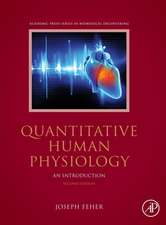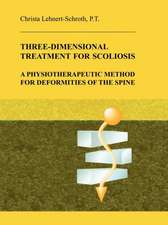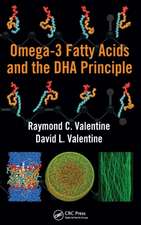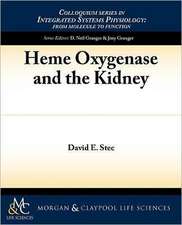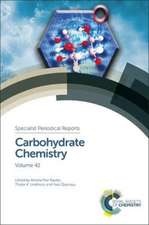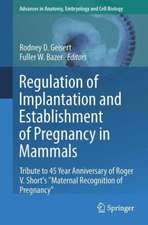Carbohydrate Chemistry: Proven Synthetic Methods, Volume 1: Carbohydrate Chemistry: Proven Synthetic Methods
Editat de Pavol Kováčen Limba Engleză Paperback – 7 iun 2019
Volume One of Carbohydrate Chemistry: Proven Synthetic Methods includes more detailed versions of protocols previously published for the synthesis of oligosaccharides, C-glycosyl compounds, sugar nucleotides, click chemistry, thioglycosides, and thioimidates, among others. The compilation of protocols covers both common and less frequently used synthetic methods as well as examples of syntheses of selected carbohydrate intermediates with general utility. The major focus of this book is devoted to the proper practice of state-of-the-art preparative procedures, including:
- References to the starting materials used, reaction setup, work-up and isolation of products, followed by identification and proof of purity of the final material
- General information regarding convenience of operation and comments on safety issues
- Versatile and practically useful methods that have not received deserved, long-lasting recognition or that are difficult to access from their primary sources
- Copies of 1D NMR spectra of compounds prepared, showing purity of materials readers can expect
| Toate formatele și edițiile | Preț | Express |
|---|---|---|
| Paperback (1) | 554.77 lei 6-8 săpt. | |
| CRC Press – 7 iun 2019 | 554.77 lei 6-8 săpt. | |
| Hardback (1) | 1337.26 lei 6-8 săpt. | |
| CRC Press – 22 sep 2011 | 1337.26 lei 6-8 săpt. |
Preț: 554.77 lei
Preț vechi: 652.67 lei
-15% Nou
Puncte Express: 832
Preț estimativ în valută:
106.17€ • 110.43$ • 87.65£
106.17€ • 110.43$ • 87.65£
Carte tipărită la comandă
Livrare economică 14-28 aprilie
Preluare comenzi: 021 569.72.76
Specificații
ISBN-13: 9780367246808
ISBN-10: 0367246805
Pagini: 468
Ilustrații: 463
Dimensiuni: 156 x 234 x 32 mm
Greutate: 0.86 kg
Ediția:1
Editura: CRC Press
Colecția CRC Press
Seria Carbohydrate Chemistry: Proven Synthetic Methods
Locul publicării:Boca Raton, United States
ISBN-10: 0367246805
Pagini: 468
Ilustrații: 463
Dimensiuni: 156 x 234 x 32 mm
Greutate: 0.86 kg
Ediția:1
Editura: CRC Press
Colecția CRC Press
Seria Carbohydrate Chemistry: Proven Synthetic Methods
Locul publicării:Boca Raton, United States
Cuprins
Synthetic Methods: Acetolysis of 6-Deoxysugars Controlled by Armed–Disarmed Effect. NaH/Im2SO2-Mediated Preparation of Hex-2- and Hex-3-Enopyranoside Enol Ethers. Enhancement of the Rate of Purdie Methylation by Me2S Catalysis. Synthesis of Oligosaccharides by Preactivation-Based Chemoselective Glycosylation of Thioglycosyl Donors. The Use of Hypophosphorous Acid in Radical Chain Deoxygenation of Carbohydrates. Diphenylsulfoxide-Trifluoromethanesulfonic Anhydride: A Potent Activator for Thioglycosides. Preparation of Glycosyl Chlorides from Glycopyranoses/Glycofuranoses under Mild Conditions. C-Glycosylation Starting from Unprotected O-Glycosides. Palladium-Catalyzed Sonogashira Coupling on p-Lodophenyl α-d-Mannopyranoside. Synthesis by "Click Chemistry" of an α-d-Mannopyranoside Having a 1,4-Disubstituted Triazole as Aglycone. Synthesis of Methyl Glycuronates by Chemo- and Regioselective TEMPO/BAIB-Oxidation. Synthesis of Sugar Nucleotides: A Phosphoramidite Approach. Conversion of N-2,2,2-Trichloroethoxycarbonyl-Protected 2-Aminoglycosides into N-Alkylated 2,3-N,O-Carbonyl Glycosides. TIBAL-Induced Rearrangement: Synthesis of gem-Difluorocarbagalactose. Pyranose-Fused Butenolides: An Expedient Preparation from Furanose Synthons. Glycal Dimerization with High Diastereoselectivity. Regioselective Debenzylation of C-Glycosylpropene. Synthesis of Azido-Functionalized Carbohydrates for the Design of Glycoconjugates. Synthesis of Thioglycosides and Thioimidates from Glycosyl Halides. Synthesis of Thioglycosides and Thioimidates from Peracetates.
Synthetic Intermediates: 2-Acetamido-4,6-O-Benzylidene-2-Deoxy-d-Glucopyranose. Synthesis of 1,3,4,6-Tetra-O-Acetyl-2-Azido-2-Deoxy-α,β-d-Glucopyranose and 2-Azido-4,6-O-Benzylidene-2-Deoxy-α,β-d-Glucopyranose. An Easy Access to 2,3,4,6-Tetra-O-Benzyl-d-Galactopyranose and 2,3,6-Tri-O-Benzyl-d-Glucopyranose. Benzyl 2,3,6,2′,3′,6′-Hexa-O-Benzyl-β-Cellobioside. One-Step Syntheses of 1,2,3,5,6-Penta-O-Benzoyl-α,β-d-Galactofuranose and 1,2,3,5-Tetra-O-Benzoyl-α,β-d-Arabinofuranose. Stereoselective Synthesis of α-C-Sialyl Compounds. Synthesis of O-Acetylated N-Acetylneuraminic Acid Glycal. Substituted Benzyl Glycosides of N-Acetylneuraminic Acid. Synthesis of 1,5-Di-C-Alkyl 1,5-Iminoxylitols Related to 1-Deoxynojirimycin. Synthesis of 1,6-Anhydro-2,3,5-Tri-O-Benzoyl-α-d-Galactofuranose. Synthesis of Prop-2-Ynyl 2,3,4,6-Tetra-O-Acetyl-α-d-Mannopyranoside. Synthesis of 3-C-(2,3,4,6-Tetra-O-Acetyl-β-d-Galactopyranosyl)prop-1-Ene. Synthesis of (E)-Methyl 4-(2,3,4,6-Tetra-O-Acetyl-β-d-Galactopyranosyl)but-2-Enoate by Cross-Metathesis Reaction. Preparation of O-β-d-Galactopyranosylhydroxylamine. Synthesis of 2,3,4,6-Tetra-O-Acetyl-1,5-Anhydro-d-Lyxo-Hex-1-Enitol and Its Conversion into a Hex-3-Enopyranosid-2-Ulose Analogue of Levoglucosenone. Efficient Synthesis of Methyl(Allyl 4-O-Acyl-2,3-Di-O-Benzyl-β-d-Galactopyranosid)uronates from d-Galacturonic Acid. Methyl(Ethyl 2,3,5-Tri-O-Benzoyl-1-Thio-α,β-d-Galactofuranosid)uronate. p-Tolyl 2,3,5-Tri-O-Benzoyl-1-Thio-α-d-Arabinofuranoside: A Useful Thioglycoside Building Block in the Synthesis of Oligoarabinofuranosides. Ethylene Dithioacetals of Common Hexoses. Preparation of 2,6-Anhydro-Aldose Tosylhydrazones. Preparation of Exo-Glycals from (C-Glycopyranosyl) formaldehyde Tosylhydrazone. Synthesis of O-(6-Deoxy-α- and β-l-Galactopyranosyl) Hydroxylamines (α- and β-l-Fucopyranosylhydroxylamines). Functionalization of Terminal Positions of Sucrose—Part I: Synthesis of 2,3,3′,4,4′-Penta-OBenzylsucrose and Differentiation of the Terminal Positions (1,6,6′). Functionalization of Terminal Positions of Sucrose—Part II: Preparation of 1′,2,3,3′,4,4′-Hexa-O-Benzylsucrose and 6,6′-Bis-O-(2-Hydroxyethyl)-1′,2,3,3′,4,4′-Hexa-O-Benzylsucrose.
Synthetic Intermediates: 2-Acetamido-4,6-O-Benzylidene-2-Deoxy-d-Glucopyranose. Synthesis of 1,3,4,6-Tetra-O-Acetyl-2-Azido-2-Deoxy-α,β-d-Glucopyranose and 2-Azido-4,6-O-Benzylidene-2-Deoxy-α,β-d-Glucopyranose. An Easy Access to 2,3,4,6-Tetra-O-Benzyl-d-Galactopyranose and 2,3,6-Tri-O-Benzyl-d-Glucopyranose. Benzyl 2,3,6,2′,3′,6′-Hexa-O-Benzyl-β-Cellobioside. One-Step Syntheses of 1,2,3,5,6-Penta-O-Benzoyl-α,β-d-Galactofuranose and 1,2,3,5-Tetra-O-Benzoyl-α,β-d-Arabinofuranose. Stereoselective Synthesis of α-C-Sialyl Compounds. Synthesis of O-Acetylated N-Acetylneuraminic Acid Glycal. Substituted Benzyl Glycosides of N-Acetylneuraminic Acid. Synthesis of 1,5-Di-C-Alkyl 1,5-Iminoxylitols Related to 1-Deoxynojirimycin. Synthesis of 1,6-Anhydro-2,3,5-Tri-O-Benzoyl-α-d-Galactofuranose. Synthesis of Prop-2-Ynyl 2,3,4,6-Tetra-O-Acetyl-α-d-Mannopyranoside. Synthesis of 3-C-(2,3,4,6-Tetra-O-Acetyl-β-d-Galactopyranosyl)prop-1-Ene. Synthesis of (E)-Methyl 4-(2,3,4,6-Tetra-O-Acetyl-β-d-Galactopyranosyl)but-2-Enoate by Cross-Metathesis Reaction. Preparation of O-β-d-Galactopyranosylhydroxylamine. Synthesis of 2,3,4,6-Tetra-O-Acetyl-1,5-Anhydro-d-Lyxo-Hex-1-Enitol and Its Conversion into a Hex-3-Enopyranosid-2-Ulose Analogue of Levoglucosenone. Efficient Synthesis of Methyl(Allyl 4-O-Acyl-2,3-Di-O-Benzyl-β-d-Galactopyranosid)uronates from d-Galacturonic Acid. Methyl(Ethyl 2,3,5-Tri-O-Benzoyl-1-Thio-α,β-d-Galactofuranosid)uronate. p-Tolyl 2,3,5-Tri-O-Benzoyl-1-Thio-α-d-Arabinofuranoside: A Useful Thioglycoside Building Block in the Synthesis of Oligoarabinofuranosides. Ethylene Dithioacetals of Common Hexoses. Preparation of 2,6-Anhydro-Aldose Tosylhydrazones. Preparation of Exo-Glycals from (C-Glycopyranosyl) formaldehyde Tosylhydrazone. Synthesis of O-(6-Deoxy-α- and β-l-Galactopyranosyl) Hydroxylamines (α- and β-l-Fucopyranosylhydroxylamines). Functionalization of Terminal Positions of Sucrose—Part I: Synthesis of 2,3,3′,4,4′-Penta-OBenzylsucrose and Differentiation of the Terminal Positions (1,6,6′). Functionalization of Terminal Positions of Sucrose—Part II: Preparation of 1′,2,3,3′,4,4′-Hexa-O-Benzylsucrose and 6,6′-Bis-O-(2-Hydroxyethyl)-1′,2,3,3′,4,4′-Hexa-O-Benzylsucrose.
Notă biografică
Series editor Pavol Kováč, Ph.D., Dr. h.c., with more than 40 years of experience in carbohydrate chemistry and more than 270 papers published in refereed scientific journals or books, is a strong promoter of good laboratory practices and a vocal critic of the publication of experimental chemistry lacking data that allows reproducibility. He obtained an MSc in Chemistry at Slovak Technical University in Bratislava (Slovakia) and a PhD in Organic Chemistry at the Institute of Chemistry, Slovak Academy of Sciences, Bratislava. After postdoctoral training at the Department of Biochemistry, Purdue University, Lafayette, Indiana (R. L. Whistler, advisor), he returned to the Institute of Chemistry and formed a group of synthetic carbohydrate chemists, active mainly in oligosaccharide chemistry, which put the Institute on the map for quality synthetic carbohydrate chemistry.
After relocating to the United States in 1981, he first worked at Bachem, Inc., Torrance, California, where he established a laboratory for production of oligonucleotides for the automated synthesis of DNA. In 1983 he joined the National Institutes of Health, where he is currently one of the Principal Investigators and Chief of the Section on Carbohydrates (NIDDK, Laboratory of Bioorganic Chemistry), the world’s oldest research group continuously working on chemistry, biochemistry, and immunology of carbohydrates, originally established by America’s greatest carbohydrate chemist, Claude S. Hudson. Dr. Kováč’s main interest is in development of conjugate vaccines for bacterial diseases from synthetic carbohydrate antigens.
After relocating to the United States in 1981, he first worked at Bachem, Inc., Torrance, California, where he established a laboratory for production of oligonucleotides for the automated synthesis of DNA. In 1983 he joined the National Institutes of Health, where he is currently one of the Principal Investigators and Chief of the Section on Carbohydrates (NIDDK, Laboratory of Bioorganic Chemistry), the world’s oldest research group continuously working on chemistry, biochemistry, and immunology of carbohydrates, originally established by America’s greatest carbohydrate chemist, Claude S. Hudson. Dr. Kováč’s main interest is in development of conjugate vaccines for bacterial diseases from synthetic carbohydrate antigens.
Recenzii
'The contributors are the best scientists in the field and the series editor is highly respected. The volumes will ... be of use to undergraduates involved in carbohydrate workshops.'
– Alexei Demchenko, Associate Professor of Chemistry and Biochemistry, Director of Graduate Studies, University of Missouri – St. Louis.
‘This essential book series, focused on carbohydrate synthesis, starts with a dedication to Nobel Laureate Sir John W. Cornforth, who is credited with the first public criticism of what he pictured as ‘pouring a large volume of unpurified sewage into the chemical literature.’1 Unfortunately, this issue is not limited to the field of chemistry as many high profile cases of irreproducible experiments have led to alarms being set off even in the popular press.2 This series then serves as the much-needed water treatment plants – places where the reader can be guaranteed a good clean reproducible experiment. … at least now chemists with or without expertise in carbohydrates can count on finding reliable procedures to make sugar-based compounds at one scale – a major achievement. Not only should current practitioners gain back time lost in attempts to properly reconstruct experimental procedures, but these procedures should also allow more creative scientists to contribute to this growing area.
– Alexei Demchenko, Associate Professor of Chemistry and Biochemistry, Director of Graduate Studies, University of Missouri – St. Louis.
‘This essential book series, focused on carbohydrate synthesis, starts with a dedication to Nobel Laureate Sir John W. Cornforth, who is credited with the first public criticism of what he pictured as ‘pouring a large volume of unpurified sewage into the chemical literature.’1 Unfortunately, this issue is not limited to the field of chemistry as many high profile cases of irreproducible experiments have led to alarms being set off even in the popular press.2 This series then serves as the much-needed water treatment plants – places where the reader can be guaranteed a good clean reproducible experiment. … at least now chemists with or without expertise in carbohydrates can count on finding reliable procedures to make sugar-based compounds at one scale – a major achievement. Not only should current practitioners gain back time lost in attempts to properly reconstruct experimental procedures, but these procedures should also allow more creative scientists to contribute to this growing area.
- Cornforth JW. Austr. J. Chem. 1993;46:157e70.
- For example, see Unreliable research: trouble at the lab. Econ. October 19, 2013.’
Descriere
Featuring worldwide contributors and a well-known series editor, the text presents new or older, not easy to find protocols generally useful to those interested in synthetic carbohydrate chemistry.





